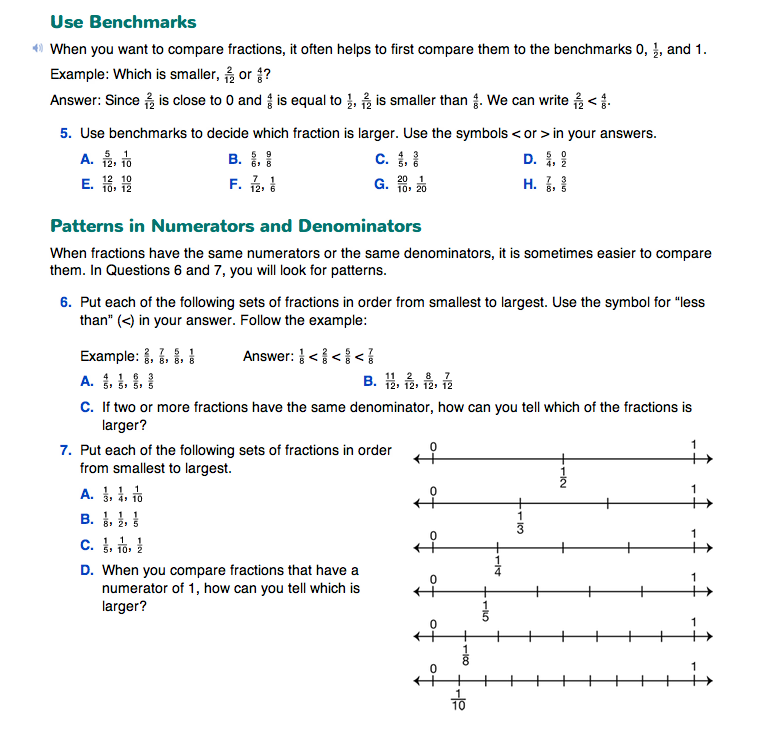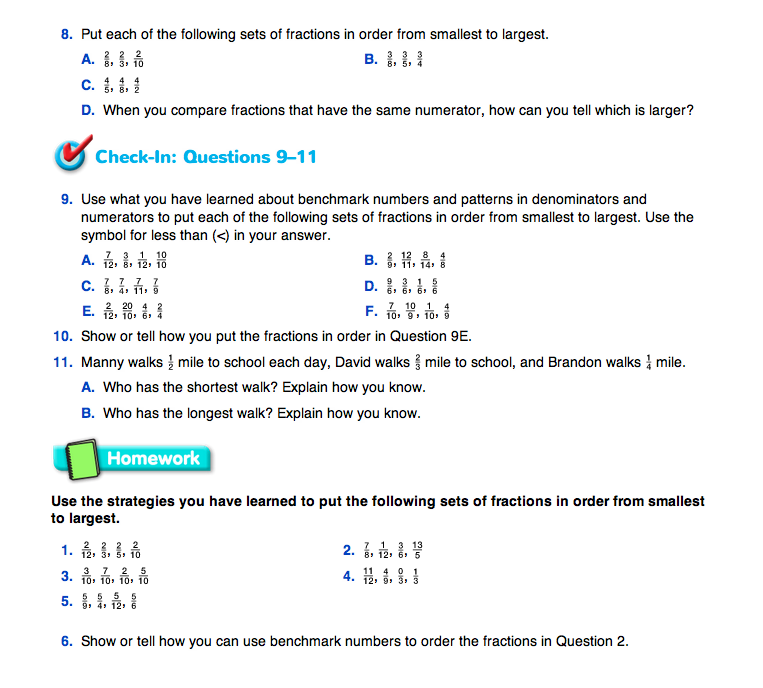Compare Fractions with Common Denominators. Direct students to the Patterns in Numerators and Denominators section of the Student Guide. In Questions 6–7, students use benchmarks on number lines to order sets of fractions from smallest to largest. Remind students that they may also use circle pieces. The fractions in Question 6 have common denominators. Students should look for patterns in the ordered fractions.
When students have finished Questions 6–7, ask:
- How can you use the numerators to order fractions from smallest to largest when all of the fractions have a common denominator? (Possible response: When the denominators are all the same, you can use the numerator to order the fractions. The smaller the numerator, the smaller the fraction.)
To further illustrate this, display the Fractions on Number Lines Chart in the Student Guide Reference section. Ask one student to show where the fractions for Question 6B ( 2/12 , 7/12 , 8/12 , 11/12 ) are on the twelfths number line as a second student builds each of these fractions using the display set of fraction circle pieces.
Compare Fractions with Common Numerators. Display the Fractions with 1 as the Numerator Master in the Teacher Guide. These number lines correspond to the set of number lines for Question 7. In Question 7, the fractions have 1 as the numerator.
Ask students to study the number lines:
- Look at these number lines. Which labeled fraction is closest to zero? ( 1/10 )
- Which fraction is farthest from zero? ( 1/2 )
- Which fraction is the largest? ( 1/2 )
- Which fraction is the smallest? ( 1/10 )
Ask students to discuss this question with their partner:
- You know that 10 is greater than 2, so why is 1/10 less than 1/2? (Possible response: The number line with 1/2 is divided in two equal parts and the number line with 1/10 is divided into 10 equal parts. The line with 10 parts has smaller parts than the line with only two parts.)
For student pairs who have trouble answering the question, use the following prompts:
- Which do you think is greater, 1/2 or 1/10? Why do you think so?
- How many equal parts is the line with 1/2 divided into? How big are the parts? Show me on the number line.
- How many equal parts is the line with 1/10 divided into? How big are the parts? Show me on the number line.
- Who gets more pizza if they share it equally, two people or a group of ten people? Why?
- Now think about fractions with numerators of 2. Label them on the number lines on the chart. (2/3, 2/4, 2/5, 2/8, 2/10 )
- Which fraction is greater, 2/3 or 2/10? (2/3)
- Order these fractions from least to greatest. (2/10, 2/8, 2/5, 2/4, 2/3)
- How can you order fractions when the numerators are all the same? (Possible response: When the numerators are all the same, like 2, you just compare the denominators. The smaller the denominator, the larger the fractional part. The larger the denominator, the smaller the fractional part. The 2 means there are two of each of these fractional parts so you just need to think about how large or how small the fractional parts are. For example, 2 eighths pieces are less than 2 fourths pieces.)
- Is this the same as when the fractions all had numerators of 1? (yes)
Ask students to use the number lines to answer Questions 7A–C and then describe a strategy for comparing fractions with common numerators of 1 in Question 7D.
If a set of fractions has the common numerator of 1, the set can be ordered using the denominators: the smaller the denominator, the larger the fraction.
Therefore: 1/10 < 1/8 < 1/5 < 1/4 < 1/3 < 1/2.
The fractions in Questions 8A–C have common numerators other than 1. A similar principle applies: When the numerators are the same, then the smaller the denominator, the larger the fraction. For example, in Question 8B:
3/8 < 3/5 < 3/4.














